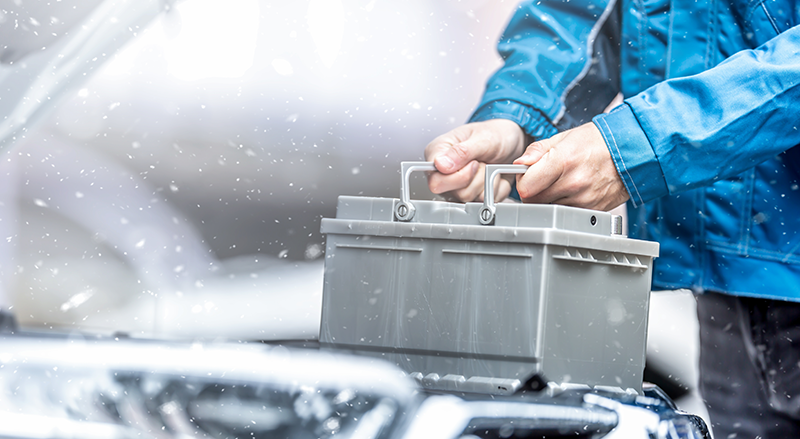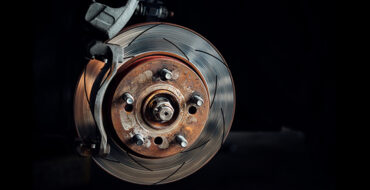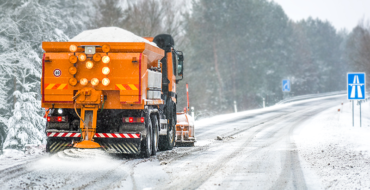Winter can be a long test of endurance on your vehicle, especially its battery. By picking a car battery that’s built to handle the tough temperatures, you can avoid the inconvenience of frequent jump starts.
Let’s go over your options and some tips for picking the right winter battery for your vehicle.

Types of Batteries
Lead-Acid
Lead-acid batteries are the oldest and most common type of car battery. They come in several types and are the most popular choice for passenger vehicles because of their affordable price and simple installation process. They usually last three to five years.
EFB
An enhanced flooded battery (EFB) is an advanced version of a lead-acid battery. It provides more energy storage, better durability, and a longer lifespan than other lead-acid batteries. These extras mean EFBs are more expensive than traditional lead-acid and standard flooded batteries. EFBs typically last up to six years and are recommended for vehicles with start-stop technology without regenerative braking.
AGM
Absorbent glass mat (AGM) batteries are leak-proof lead-acid batteries that require less maintenance than standard lead-acid batteries. AGM batteries often last longer than other lead-acid batteries, but they’re more expensive. AGM batteries usually last between five and eight years (sometimes longer) and are ideal for cars with stop-start technology.
Lithium-Ion
Almost all electric vehicles use lithium-ion batteries, including hybrids. They have the longest lifespan of all car batteries, lasting between ten and twenty years. However, they’re significantly more expensive than other battery types.

Choosing a Battery for Winter
When choosing a replacement winter car battery, consider the following criteria:
- Cold cranking amp (CAA) rating: CAA indicates how many amps a battery can deliver for 30 seconds at -17°C without dropping below 7.2 V. The CAA rating you need will depend on your specific vehicle and any aftermarket accessories you have on it.
- Reserve capacity (RC): RC states how many minutes a charged battery will discharge 25 amps at 26°C degrees until the battery drops below 10.5 V. The higher the RC rating, the better.
Of the four types we’ve outlined, AGM and lithium batteries are the best at handling extreme temperatures.
AGM batteries have a higher CAA rating than most other batteries, helping them withstand winter weather. They have a low self-discharge rate and can be stored for long periods of time without needing to be charged.
Lithium-ion batteries warm up as you use them, lowering their resistance and increasing the voltage. Lead-acid batteries, on the other hand, become weaker the further they travel in cold weather. Standard lead-acid batteries can lose up to 20% capacity in the cold. If the temperature goes below -30C, this loss can drop to 50%.
So, if you’re looking for a dependable energy source to get you through the winter, an AGM battery is your best option for a gas-powered vehicle, and lithium-ion is ideal for electric vehicles.
If you need to power an RV this winter, look for a deep cycle battery. These don’t work in passenger vehicles, because they’re designed to safely discharge more energy. Put the wrong battery in the wrong vehicle, and you’ll find yourself in trouble. You can find more information on deep cycle batteries here.
Maintaining Your Battery
Whichever battery you choose, it’s important you maintain it regularly to help it last you through the winter and beyond. However, this maintenance routine will look different depending on the specific battery you have. Keep these tips in mind as you draft your battery maintenance schedule:
- Lead-acid batteries require standard maintenance, including cleaning once or twice a year. You can find a full guide to these tasks here.
- EFB and AGM batteries shouldn’t be charged above 14.4 V.
- Keep lithium-ion batteries charged between 14.2 V and 14.6 V.
- The best way to maintain any battery is to drive your vehicle at least once every three or four days and avoid taking lots of short journeys.
- To prevent your battery from dying, avoid leaving your car exposed overnight in the winter. A battery blanket can also help.
- Keep a booster pack or booster cables in your trunk in case of battery emergencies on the road.
For any questions about choosing or maintaining a winter battery, visit a NAPA Auto Parts store to speak with an expert. You can also browse through an extensive selection of batteries and other automotive-related products on NAPACanada.com. To be matched with items guaranteed to fit, input your vehicle details in the top left corner of the website.

Temro Battery Blanket 50W 120V 28 In 71Cm
45.69 $ 39.09 $
Buy Now

Clore Automotive 1500 Peak Amp 12 Volt Jump Starter Booster Pac
269.99 $ 228.99 $
Buy Now







